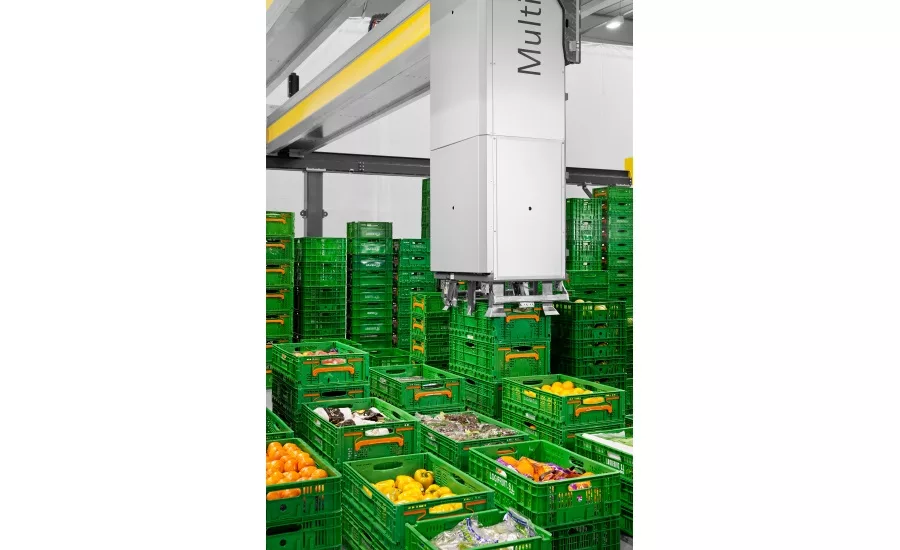Freshness matters: why it's time to automate distribution

For food manufacturers and retailers, one of the most critical points in the supply chain is distribution, as the accuracy and efficiency of order fulfillment has a direct impact on the quality, freshness and safety of goods on store shelves. But within the distribution center itself, operational challenges can often hinder product flow, especially in facilities that rely on manual processes. Employees have to run up and down aisles, handpick items, lift heavy crates or boxes and prepare orders for shipment. Distribution becomes highly prone to human error and too slow to keep up in today’s high-demand market.
Instead, through automation, food manufacturers and retailers can take control of order fulfillment and manage their entire operation, from when goods enter the distribution center, through storage and all the way to dispatch. Automated warehouses are able to not only maximize product freshness, but also address modern challenges in dealing with greater consumer demand and seasonal spikes in business.
Maximizing freshness and product shelf life
Food distribution centers handling perishable products, like fruits and vegetables, need to transport goods from supplier to shelf as fast as possible in order to maintain freshness and minimize spoilage. Yet many facilities that have wanted to automate—in order to cut down lead times—have been unable to, as conventional automated warehousing systems run storage and order picking as separate functions. Fortunately, there are now more innovative solutions available—ones that integrate product handling and picking into a single system. Ideal for facilities that store fresh goods in plastic crates, totes or trays, such a system can handle both operations simultaneously. New products can arrive and be picked immediately, enabling faster handling and shorter lead times. With the goal of delivering fresher products to market, Spanish supermarket giant Mercadona adopted this type of solution in its Guadix, Granada distribution center.
Mercadona installed robots to provide buffer storage and order picking as one flexible operation. The robots are responsible for handling Mercadona’s fresh fruit, vegetables and meat stored in refrigerated areas. These products account for around 300 SKUs in some 30,000 crates. The system handles all goods reception, storage, retrieval, picking, sorting, and loading. It is fully integrated with the facility’s manual operations, so Mercadona can prepare orders for its entire base of over 1,600 supermarket stores, without the need for further processing.
Meeting greater consumer demands
In response to increased consumer demand for more selection and faster delivery times, food and beverage companies have expanded their selections, offering more sizes, flavors and packaging types than ever before—not to mention new organic, vegan and gluten-free options. The result is an explosion in the number of SKUs in the warehouse. Manual facilities, once built to house a hundred units, now have to try to accommodate several thousand, while ensuring efficient storage and retrieval.
Looking for quick answers on food safety topics?
Try Ask FSM, our new smart AI search tool.
Ask FSM →
But by automating and implementing a high-density storage design, distribution centers that struggle with SKU proliferation can find new space savings, using up to 50 percent less storage area than traditional, manual means. They can thereby capitalize on their existing space—and have room to spare. Olvi, a 140-year-old traditional brewery in Finland, faced a very similar challenge, where market demand for new packaging and products caused a jump from 200 to 350 SKUs.
Coupled with consumer demand for more frequent, smaller-sized orders, the rise in SKUs led Olvi to turn to automation in order to optimize its warehouse capacity and picking efficiency. Using a combination of robotics and warehouse control software, Olvi now rapidly picks products stored in stacked pallets on its warehouse floor. With this space-saving design, Olvi has actually doubled its previously available space, leaving room for growth and expansion.
Keeping up during seasonal peaks
Challenges in efficiency and space utilization only compound during seasonal peaks, especially for facilities already stretched thin in terms of available labor and resources. On top of having to keep up with a higher volume of orders, many have to manage more inventory due to increased output from manufacturing to satisfy demand. Some try to address the problem by hiring seasonal employees, but that creates new challenges in added labor costs and the need to train temporary staff in just a short span of time.
Distribution centers can fill the gaps left by labor shortages—and offset the costs and challenges of hiring seasonal staff—using the speed and accuracy of automation. Such automated materials handling solutions can provide accurate, timely deliveries year-round. Challenges with seasonal spikes led Martin’s Famous Pastry Shoppe, Inc. to automate distribution in its once completely manual warehouse in Chambersburg, Pennsylvania. For the bread producer, summer is one of the best times of the year for sales. But while good for business, the seasonal spike presented major efficiency challenges and safety risks for its warehouse staff who had to handpick orders for dispatch.
Through a combination of high-density pallet storage and robotic order picking, Martin’s Famous Pastry Shoppe, Inc. now has a fully automated process that rapidly moves product from production to storage, to order picking to palletizing, and finally trailer loading. The facility is fully equipped to keep up during seasonal highs and lows. With automation taking over order fulfillment, it has been able to reduce its workforce and man hours by 30 percent, and eliminate the safety risks in manual operations.
For food and beverage companies currently struggling with product freshness, SKU proliferation and seasonal peaks, it will only become harder—or nearly impossible—to overcome these challenges without some help via automation. Those that choose to automate now will be ready and able to deliver only the freshest products to consumers (no matter how much demand rises)—with the flexibility and speed to meet any new challenges in the future.








